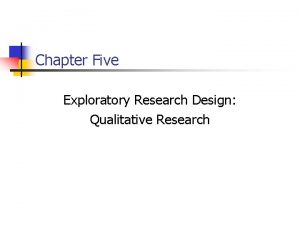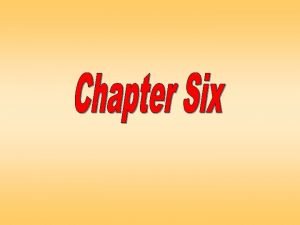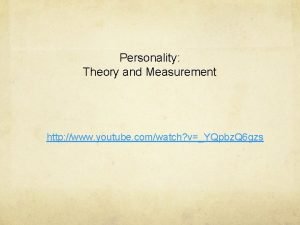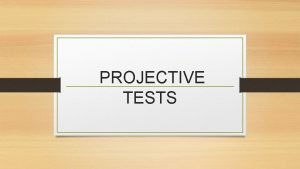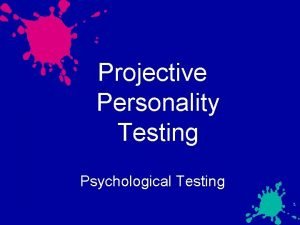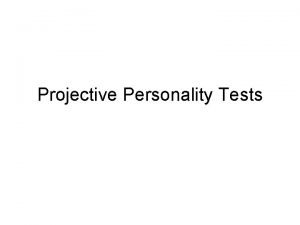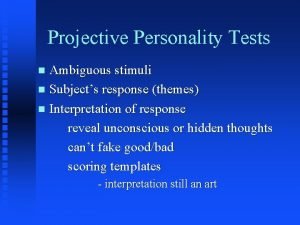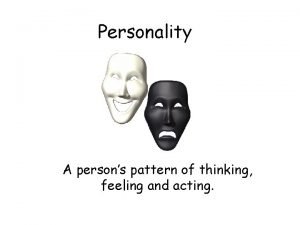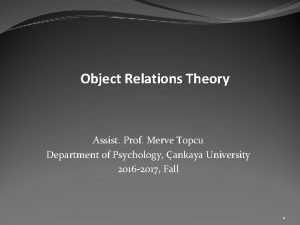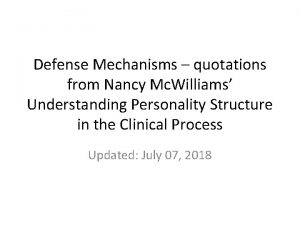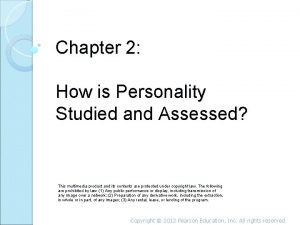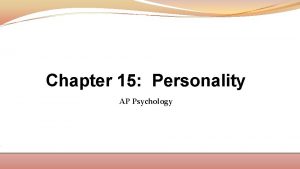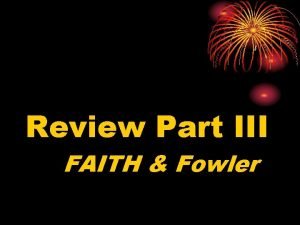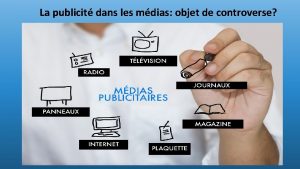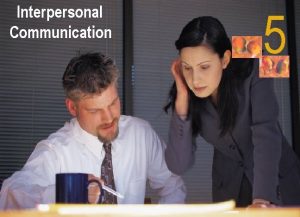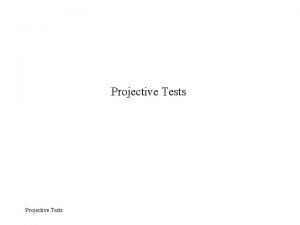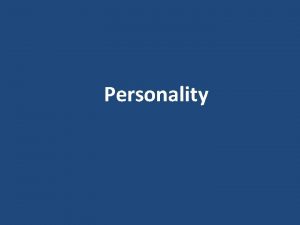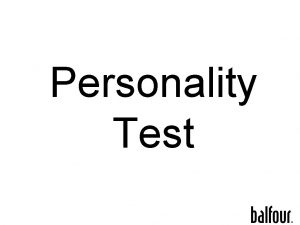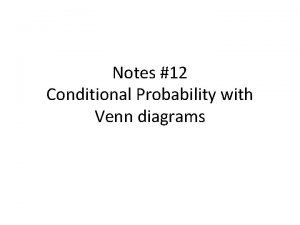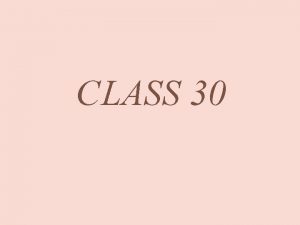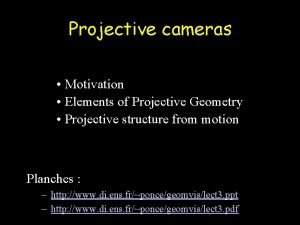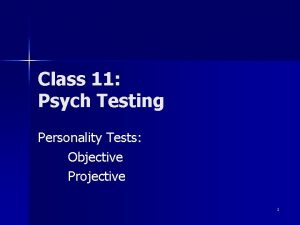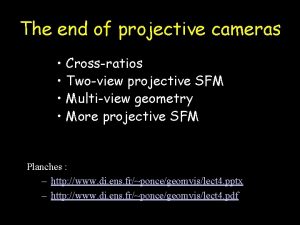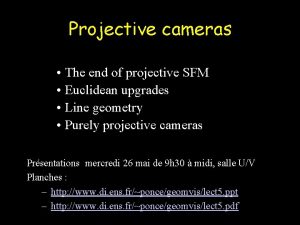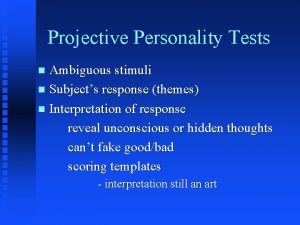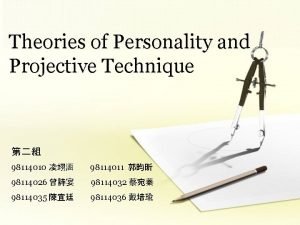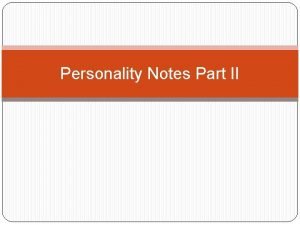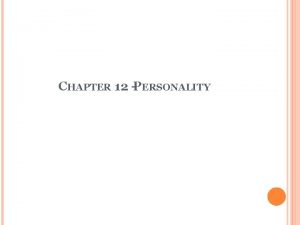Class 12 Personality Tests Projective 1 Personality Tests
































![n Sample interpretation : “Roses [name] does present some unusual features for the house n Sample interpretation : “Roses [name] does present some unusual features for the house](https://slidetodoc.com/presentation_image_h2/90d3565cc1200b0125aa006d05ae866f/image-33.jpg)




- Slides: 37

Class 12 Personality Tests: Projective 1

Personality Tests overview A. Objective tests (Class 11) n 1. Types of tests (with examples) n 2. Response sets and faking n 3. Samples of tests: B. Projective tests (Class 12) n Introduction n n n Inkblots: Rorschach. Holtzman: Jules Joannini Thematic Apperception Test/Children’s AT: Jasmine Ruoff Incomplete Sentence Blanks Human Figure Drawings: Jenny Kepler House-Tree-Person 2 Kinetic Family Drawings

B. Projective tests: Introduction n n By contrast with “objective tests” where there is a “forced choice” format, projective tests are open-ended. Based on the projective hypothesis: when faced with an ambiguous stimulus, the response is generated by the individual’s psychological dynamics, some of them unconscious (a traditional psychodynamic idea): – One’s desires, fears, motives; defenses, etc. The response reflects the way the client’s perception and cognition work, the way in which the client structures her/his psychic world Although supported by psychoanalytic thinking, non PSA clinicians have found projectives very useful. – Could be CBT therapist and use projectives n n 5 of the 7 most popular tests used by psychologists are projectives Hogan’s attitude is skeptical—typical of academic researchers, vs. clinicians—finding projectives helpful 3

B. Projective tests: Introduction n Differing types of uses: – Informally: Clinician forms general impression of meaning, using symbols; no attempt to score vs. – Standardized administration and scoring; complex scoring, interpretation (e. g. , Exner scoring, Rorschach) – To generate hypotheses to be evaluated—by you n Differential value of objective vs. projective tests: – if reading level is low, or there is suspicion of faking good or bad, a projective test may be useful. Why? – Also, if the personality or psychopathology issues are quite unclear, projective tests offer a broad range of understandings whereas objective tests can be limited by the categories built into the test. 4

Bender Gestalt Visual Motor Test n n n n Some tests have multiple purposes: projective, memory, neuropsychological (e. g. , Bender Gestalt) Developed in 1938 initially by Lauretta Bender. Based on Gestalt psychology principles (the whole is perceived as greater than the parts; “Law of Pragnanz”: the brain simplifies perception) The purpose: to examine the brain’s ability to coordinate the whole, with “deficits” arising normally in early childhood (immature development yet) or later (as a result of damage to the visual cortex—therefore screening test for brain damage). Images placed on 3 x 5 cards Revised several times over the years, most recently as the Bender II (1990 s) To provide an example of this simple measure (often used as a warm-up, non-threatening exercise: 5

Bender Gestalt “Copy while in view” Q: Visual motor coordination? Measure of potential organic damage Also interpretation may indicate personality features And memory test. 6

Clinical Cases: WNL 7

Examples of Errors Test Item Rotation error 8

Examples of BGT-R Errors: Retrogression Test Item Retrogression error 9

Examples of BGT-R Errors: Test Item Simplification 10

Example of BGT-II performance. 11

1. Rorschach Inkblot Test: Introduction n n Swiss psychiatrist working in a mental hospital experimented with many inkblots, before selection of 10 as most likely to trigger a variety of responses. Initially interested in introversion and extroversion He published the blots in 1921, and a year later was killed in an auto accident. Others have taken up the task of making the blots into a useable test with scoring systems. Some blots are achromatic—only grays and black; some have red added, and others are chromatic (color only). 12

13

Rorschach theory n n n Purpose: assess personality characteristics, thinking style (including identifying thought disorder vs. non-psychotic thinking), and emotional function (and control of affect), among other variables. – But not to diagnose necessarily: rather an understanding of mental function in an individual Criticisms include: – Can “objective” conclusions be made (vs. only subjective)? That is, is it possible to have inter-rater agreement and interpretation? (cf. Exner shortly) 2 schools of thought in interpreting: – Do extensive quantitative studies to see what types of responses are related to which kind of psychological processes (behaviors/ways of thinking/emotions) (Beck) – What kinds of symbolic meaning is present in the 14 responses, using a knowledge of the human psyche? (Klopfer)

1. Rorschach Inkblot Test: Scoring and controversy n Scoring systems: n Currently there is a hot controversy over whether the Rorschach succeeds or not (Wood, Lillianfeld): – the current and most popular scoring system in the US is by Exner: – He combined elements of several different earlier scoring systems, and did extensive research on typical and atypical responses to the blots (using Beck’s too). – He calls his system the Comprehensive System. The amount of research is remarkable. – One of his goals was to make a test that could stand up in the face of demands that there be clear and strong evidence for conclusions drawn from it (e. g. , court). – about three years ago, Scientific American published an article against it, at about the same time that several professional journals came out with major articles in 15 support of it.

Rorschach administration Two phases typically in administering the test: n “Free association” or response phase: – The client is asked to tell whatever s/he sees: “What might this be? ” If the patient only reports one percept; s/he is encouraged to report more, by saying “most people see more. ” – Task is not to “make up a story” or image; – Calls only for perceptual experience – The examiner writes down the responses verbatim. Likely there will be several responses/card or blot – A minimum of 14 responses are required to allow scoring using Exner’s system. The actual number varies widely; a small number might suggest? A large number? n “Inquiry”: – After all 10 cards have been responded to, the examiner returns to the first response, and for each response, asks the patient to respond to the prompt: “what made it ll that? ” 16 – This sets the stage for scoring each response.

An Inkblot: what might it be? n Your initial impressions? Share with others—note differences/similarities 17

Card 1 with sample response 18

Example of responses to an image n n n 1. LL a dog, like a wolf I: His ears are here; the whole thing is the head, face, eyes, chin, and his snout terminating at the bottom; a face-on shot. These little open spaces [white] may indicate the sides of a smiling maw 2. Maybe a guy w wings I: Little hands up here, but he has a crease down the middle of his head; is it brain damage? And wings; may be floating down for a landing. 3. I’m going to stick w a face theme: LL a guy w horns that has a bloodied nose. I: 2 eyes here; 2 horns at the top of his head; a hole in the center of his face. We’ll ignore that. His nose ll its bloodied bec it’s red and uneven. 19

20

Rorschach variables: Exner n Location (which part, or how much, of the blot was used): n W, D, Dd, S (ability to see the whole vs. focus on details) Determinants: the specific properties of the blot that the person uses to form a response (below): Developmental quality or integrative ability. n Form quality n Other determinants: to what extent does the viewer use n – + (synthesized), o, v(ague): – complexity/sophistication of thought – how much does the shape on the blot influence the person’s response; – how common is it. – Seen as use of thought. these aspects? (with a common interpretation) n n n Shading: Anxiety Color: Quality of affect Texture: Need for nurturance Movement: Conscious to unconscious motivating forces Reflections: Ego-centricity Content of images not evaluated at 1 st: – E. g. , symbolic meanings of percepts 21

Rorschach variables n Contents: what categories do the percepts fall into? (but still not symbolic meaning) – Humans? Animals? Inanimate objects? – Sexuality? X-rays? Etc. n Populars: (why would that be used? ) n Special Scores: e. g. – Unusually low? frequent? – morbid, cooperative, aggression; – illogical, incongruous, incoherent reasoning: e. g. s: n n n Neologisms (cat sticking her “purr” up) Odd combinations (four legged chicken, butterflower) Odd logic (must be lettuce because it’s next to a rabbit) Rather than dx, description of personality is of interest Via use of relative frequency of various scores and combination of determinants Content analysis (the potential symbolism of the images) is analyzed separately 22

Holtzman: Jules Joannini n Thematic Apperception Test/Children’s AT: Jasmine Ruoff n Human Figure Drawings: Jenny Kepler n 23

4. Human Figure Drawings n n Many different variations on a theme: that self-generated drawings allow projection of one’s psychological issues. Some versions: DAP (draw a person); HTP (House-Tree. Person); KFD (Kinetic Family Drawing) Some of these drawings have been used for other purposes too – e. g. , the DAP as non-verbal intelligence tests (for children in particular) – norms spelling out the age of the inclusion of different features. – E. g. , at very young ages, just expect a simple face (eyes, mouth) and stick figure body. – At increasing ages, expect more detail (nose, ears, hair in the face; a body with more than a stick figure). Also used as a therapy tool : – it allows a child to express in non-verbal ways that which they may not be able to or feel free to say. – In this case, the drawing can be a lead into talking about, or further drawings to work with in a session. 24 – This is especially useful in understanding the family with the

Draw a Man/Person n n n Also called Goodenough-Harris Draw a Person Devised in 1926 by Florence Goodenough as a measure of intelligence (Draw a Man) Children are asked to draw a person, then person of the opposite sex, and then themselves. Rarely takes more than 10 -15 m Harris (1963) provides scoring scales to evaluate level of cognitive development; does not require expressive language by the child. Also used as a projective—e. g. , examining missing parts; exaggerated elements (keeping developmental norms in mind) Considered non-invasive and non-threatening to 25 children

n From http: //www. nucleuslearning. com/conte nt/draw-person-test-dap-great-way-tell -kids-intelligence 26

Human figure drawings norms n n At the age of 3 kids start to draw circles and lines, but usually can't really make a stick figure look like a person. At the age of 4, start drawing people more with: head, arms, legs. But at the age of 4 (mental age of 4) most kids draw the arms and legs coming out of their heads - no body. At the age of 5, children start drawing bodies, arms and legs coming from the bodies. Then, between 5 and 5. 5, kids start to draw more detail, including 3 fingers (not 5), clothes, etc. 27 n From http: //www. nucleuslearning. com/content/draw-person-test-dap-great-way

28

From a study of the impact of pesticides: 29 An Anthropological Approach to the Evaluation of Preschool Children Exposed to Pesticides in

House-Tree-Person (HTP) n n n n Developed in 1948 by Buck; updated 1969 Can be used for personality or neurological measure Asked to draw 4 pictures: H, T, P 1, P 2 Questions can be asked about each drawing afterwards. E. g. , Tell a story about this…[house, tree, etc]; is it a happy [house]; is the tree alive? What is the person feeling/thinking/doing? (aka TAT) H: sense of family/self/intimate relations T: sense of unconscious self/motives P: Most conscious aspect of self/others Poor validity, reliability; highly subjective interpretation. However, can provide unexpected 30 insights; can be used in art therapy

n http: //images. google. com/imgres? imgurl=ht tp: //psihologia. net/durvoo. jpg&imgrefurl=ht tp: //www. psihologia. net/forum/viewtopic. ph p%3 Ft%3 D 159&usg=__uws 7 Zwu 3 B 2 PYl. T 3 J n. Nuc 2 pn 9 h. KM=&h=330&w=466&sz=51&hl =en&start=9&um=1&tbnid=RAIky. EGHDr 0 u 8 M: &tbnh=91&tbnw=128&prev=/images% 3 Fq%3 DKinetic%2 BFamily%2 BDrawing%26 hl%3 Den%26 rlz%3 D 1 T 4 GGLR_en. US 311 US 3 11%26 sa%3 DN%26 um%3 D 1 31

32
![n Sample interpretation Roses name does present some unusual features for the house n Sample interpretation : “Roses [name] does present some unusual features for the house](https://slidetodoc.com/presentation_image_h2/90d3565cc1200b0125aa006d05ae866f/image-33.jpg)
n Sample interpretation : “Roses [name] does present some unusual features for the house drawing. It is uncommon … to see a house drawn in mainly profile [3 -d side view]. The vast majority of drawers will draw a house where the front of the house is face onto the viewer. … Indeed the most front on wall of the house to the viewer is the side wall. A complete profile is sometimes viewed as an avoidance reaction to intimate relationships so it is quite likely that there is some of this indicated in the drawing. However there is a large door and the windows are also large and these can indicate accessibility in the personality. However if you have a close look at the drawing there is quite heavy shading on the door and that can indicate a barrier of defensiveness, in this instance to human contact. Also there is no door knob on the door. In summary this picture gives a clear indication of quite strong ambivalence in the drawer. The desire and need to seek out human contact and relationships whilst at the same time having a need to avoid and shy away from such contact. This could lead to those with whom Roses has contact feeling confused at times. 33 They will pick up both her need to seek out and the need to avoid human contact at the same time. ”

Kinetic Family Drawings n n n n Request a drawing of the family doing something Purpose: to understand better via non-verbal means the relations among family members Also potentially useful as an art therapy technique: to work with children’s feelings/beliefs that are difficult to articulate Sometimes used to evaluate cases of reported child abuse Interpretation with caution due to limited validity support (and so likely inappropriate in forensic settings) The child is told to include all family members, including themselves Can ask about what is happening; who is in the picture Note absences, unexpected relations/sizes, erasures, relations and positions of individuals, missing parts of 34 bodies, etc.

n www. expressyourselfarttherapy. com/id 20. htm 35

36

Myers-Briggs: free version http: //www. humanmetrics. com/cgiwin/JTypes 3. asp n Another version: Keirsey n 37
 Advantages of projective tests
Advantages of projective tests Qualitative research procedures
Qualitative research procedures Advantage of focus groups
Advantage of focus groups Objective personality
Objective personality Define projective test in psychology
Define projective test in psychology Projective hypothesis definition
Projective hypothesis definition Ace different tests iq tests but
Ace different tests iq tests but Rorschach projective test
Rorschach projective test Personality test
Personality test Tests that present ambiguous stimuli
Tests that present ambiguous stimuli Absolute conic
Absolute conic Barnum effect
Barnum effect Bad breast theory
Bad breast theory What's labeling theory
What's labeling theory Identification defense mechanism
Identification defense mechanism Projective test example
Projective test example Freudian slip meaning
Freudian slip meaning Intuitive projective faith
Intuitive projective faith Projective monitor
Projective monitor Projective monitor
Projective monitor Publicité mécaniste
Publicité mécaniste Projective listening
Projective listening Strengths and weaknesses of psychodynamic theory
Strengths and weaknesses of psychodynamic theory Rorschach brad pitt
Rorschach brad pitt Projective techniques of data collection
Projective techniques of data collection Greek personality test
Greek personality test Personality pig test
Personality pig test Probability of a and not b venn diagram
Probability of a and not b venn diagram Antisocial personality disorder ελληνικα
Antisocial personality disorder ελληνικα In today's class
In today's class Package mypackage; class first { /* class body */ }
Package mypackage; class first { /* class body */ } Difference between abstract class and concrete class
Difference between abstract class and concrete class What is the lower boundary of the modal class
What is the lower boundary of the modal class Class i vs class ii mhc
Class i vs class ii mhc Abstract concrete class relationship
Abstract concrete class relationship How to get class mark
How to get class mark Stimuli vs stimulus
Stimuli vs stimulus Discriminative stimulus
Discriminative stimulus

